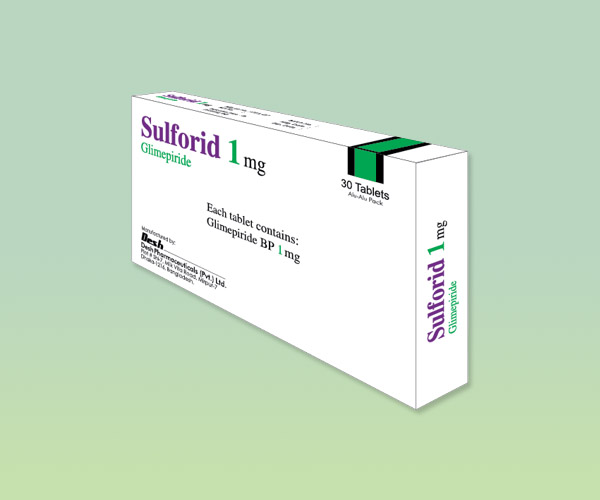Sulforid 1 mg Tablet
Glimepiride 1 mg
Sulforid 1 mg Tablet
Glimepiride 1 mg
Composition
Product name:
1) Sulforid 1 Tablet : Each tablet contains Glimepiride BP 1 mg.
- AVAILABILITY: AVAILABLE
Pharmacology
The product contains Glimepiride which is an oral blood-glucose-lowering drug of the sulphonylurea class. Chemically Glimepiride is identified as 1-[[p- [2-(3-ethyl-4-methyl-2-oxo-3-pyrroline-1-carboxamido) ethyl]phenyl] sulphonyl]-3-(trans-4-methylcyclohexyl) urea. The primary mechanism of action of Glimepiride is the lowering of blood glucose by stimulating the release of insulin from functioning pancreatic beta cells. In addition, extrapancreatic effects may also play a vital role in the activity of Glimepiride. Administration of the product can lead to an increase in the sensitivity of peripheral tissues to insulin.
Indication
Non-insulin-dependent (type-II) diabetes, whenever blood sugar levels cannot be controlled adequately by diet, physical exercise and weight reduction.
It is also indicated for use in combination with Insulin to lower blood glucose in patients whose hyperglycemia can not be controlled by diet and exercise or in conjunction with an oral hypoglycemic agent.
Dose & administration
In principle, the dosage of the product is governed by the desired blood sugar level. The dosage must be the lowest which is sufficient to achieve the desired metabolic control.
The initial and the maintenance doses are set based on the results of regular checking of glucose in blood and urine. Monitoring of glucose levels in blood and urine also serves to detect either primary or secondary failure of therapy.
Initial dose and dose titration: Usual initial dose is 1 mg once daily. If necessary, the daily dose can be increased. Any increase can be based on regular blood sugar monitoring, and should be gradual, i.e., at intervals of one to two weeks and carried out stepwise at follows: 1 mg-2 mg-3 mg-4 mg-6 mg.
Dose range in patients with well-controlled diabetes: Usual dose range in patients with well-controlled diabetes is 1 to 4 mg daily.
Distribution of doses: The timing and distribution of doses are decided by the physician, in consideration of the patient's current lifestyle. Normally, a single daily dose is sufficient. This should be taken immediately before a substantial breakfast or - if none is taken - immediately before the first main meal. It is very important not to skip meals after taking the drug.
Secondary dosage adjustment: As the control of diabetes improves, sensitivity to insulin increases; therefore, its requirement may fall as treatment proceeds. To avoid hypoglycemia, timely dose reduction or cessation of Glimepiride therapy must be considered.
A dose adjustment must also be considered whenever the patient's weight or lifestyle changes or other factors arise which cause increased susceptibility to hypo- or hyperglycemia.
Changeover from other oral antidiabetics to Glimepiride: There is no exact dosage relationship between Glimepiride and other oral blood sugar-lowering agents. When substituting Glimepiride for other such agents, the initial daily dose is 1 mg; this applies even in changeover from the maximum dose of other oral blood sugar-lowering agents. Any dose increase should be in accordance with the guidelines given above in the initial dose and dose titration.
Consideration must be given to the potency and duration of action of the previous blood sugar-lowering agent. It may be necessary to interrupt treatment to avoid additive effects which would increase the risk of hypoglycemia.
Administration: Glimepiride tablet must be swallowed without chewing and with a sufficient amount of liquid (approximately ½ glasses).
Contraindication
Glimepiride is not suitable for the treatment of insulin-dependent (type-I) diabetes mellitus, or of diabetic pre-coma or coma. Glimepiride must not be used in patients hypersensitive to Glimepiride or other sulfonylureas.
Warnings and precautions
In the initial weeks of treatment, the risk of hypoglycemia may be increased and necessitates careful monitoring. If such risk is present it may be necessary to adjust the dosage of Glimepiride. Hypoglycemia can almost always be promptly controlled by immediate intake of carbohydrates (glucose or sugar, e.g., sugar-sweetened fruit juice or sugar-sweetened tea).
Side effects
Hypoglycemia, temporary visual impairment, nausea, vomiting, diarrhoea, abdominal pain, urticaria, and fall in blood pressure.
Use in pregnancy and lactation
Pregnancy: Glimepiride must not be taken during pregnancy; a changeover to Insulin is necessary. Patients planning a pregnancy must inform their physician and should be shifted to insulin.
Lactation: Ingestion of Glimepiride with breast milk may harm the child. Therefore, Glimepiride must not be taken by lactating women. Either a changeover or a complete discontinuation of breastfeeding is necessary.
Use in children, adolescents& elderly patients
Glimepiride isn’t recommended for people under 18 years old because it may affect body weight and cause low blood sugar.
Senior dosage (ages 65 years and older)
• The starting dose is 1 mg taken once per day with breakfast or the first main meal of the day.
• Your doctor may adjust your dose based on your blood sugar levels. Since seniors may be more sensitive to glimepiride and are more likely to have decreased kidney function, your doctor may increase your dose more slowly.
• The maximum recommended dose is 8 mg taken once per day.
Drug interactions
Potentiation of the blood-sugar-lowering effect may occur with Insulin and other oral anti-diabetics, ACE inhibitors, Allopurinol, anabolic steroids and male sex hormones, Chloramphenicol, coumarin derivatives, Fluoxetine, MAO inhibitors, Miconazole, Para-aminosalicylic acid, Pentoxifylline (high dose parenteral), Phenylbutazone, Oxyphenbutazone, quinolones, salicylates, sulphonamides, tetracyclines, blockers.
Weakening of the blood-sugar-lowering effect may occur with Acetazolamide, barbiturates, corticosteroids, Diazoxide, diuretics, Epinephrine and other sympathomimetic agents, laxatives, estrogens and progestogens, phenothiazines, Phenytoin, Rifampicin, and thyroid hormones.
H2 -receptor antagonists, Clonidine and Reserpine may lead to either potentiation or weakening of the blood-sugar-lowering effect.
Both acute and chronic alcohol intake may potentiate or weaken the blood-sugar-lowering action of Glimepiride unpredictably.
Overdose
Overdosage of sulfonylureas, including Glimepiride, can produce hypoglycemia. Mild hypoglycemic symptoms without loss of consciousness or neurologic findings should be treated aggressively with oral glucose and adjustments in drug dosage or meal patterns. Close monitoring should continue until the physician is assured that the patient is out of danger. Severe hypoglycemic reactions with coma, seizure, or other neurological impairment occur infrequently but constitute medical emergencies requiring immediate hospitalization. If hypoglycemic coma is diagnosed or suspected, the patient should be given a rapid intravenous injection of concentrated (50%) glucose solution. This should be followed by a continuous infusion of a more dilute (10%) glucose solution at a rate that will maintain the blood glucose at a level above 100 mg/dl. Patients should be closely monitored for a minimum of 24 to 48 hours, because hypoglycemia may recur after apparent clinical recovery.
Storage
Store in a cool, dry place below 25 °C and protect from light. Keep out of reach of children.
Packing
Sulforid 1 Tablet: Box containing 2×15 tablets in blister pack
